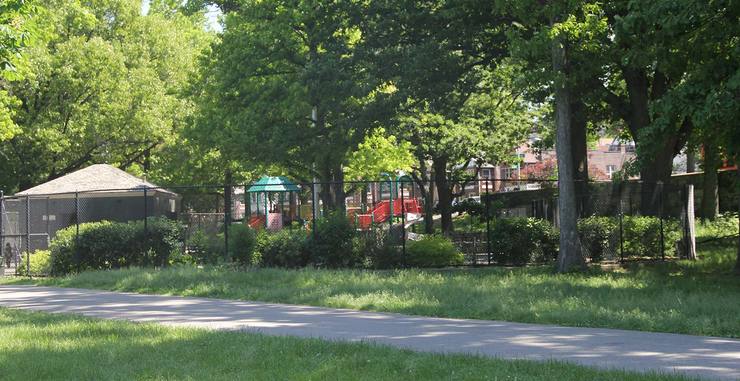
Rosewood
Playground in Bronx Park near Rosewood Street and Bronx Park East,
June 2014. Like so many of New York City's parks, Rosewood Playground was a
WPA project. Construction began in 1940 and was completed in 1941.
References:
- Department of Parks Press Release, July 29, 1940: “The Department of Parks has started the reconstruction of the northerly end of Bronx Park. This is another step in the plan to build it so that in addition to housing the Zoological and Botanical Gardens, it will serve the neighborhood. For years all of the park was under the jurisdiction of the New York Botanical Garden and the New York Zoological Society. 1937 the Park Commissioner reached an agreement with these two organizations which provided for the release of property required for the southerly extension of the Bronx River Parkway through Bronx Park and also sufficient land along the easterly and northerly boundaries to provide recreation for the people living in the abutting areas. Up to this time, there was very little opportunity for active recreation in the park. Four playgrounds along the easterly boundary have already been opened to the public and the construction of this northerly area will fill a real community need. It will be developed with two children's playgrounds, one on the westerly side near 204 Street, and the other on Bronx Boulevard opposite Rosewood Street. Two softball diamonds and also a regulation baseball diamond will be provided. As a step toward the completion of this improvement the Transit Commission will start work Monday on the alteration and reconstruction of two bridges over the New York Central Railroad on the westerly boundary of Bronx Park. The existing bridge at Mosholu Parkway will be altered and added to in order to provide additional traffic lanes which will be a part of the Mosholu Parkway connection to the Bronx River Parkway Extension which is to be rebuilt on a now line through the easterly portion of Bronx Park. This bridge will be a link in what will be ultimately a parkway connection between the Henry Hudson Parkway in Van Cortlandt Park and Bronx River Parkway. The present Mosholu Parkway will form a portion of this link. The bridge at 204th Street will be remodeled for pedestrians use only. Automobile traffic will be eliminated and this bridge will become the principal pedestrian entrance to the portion of Bronx Park north of Mosholu Parkway now being developed by the Department of Parks as a recreation area.”
- Department of Parks Press Release, Sunday June 22, 1941: “The Department of Parks announces the the completion of work in the northern section of Bronx Park ... Certain features of the complete development plan prepared by the Department of Parks have been embodied in the present work preformed by the Works Progress Administration. These include construction of sections of the future path system, two softball diamonds, two comfort stations and two marginal playgounds. One of these playgrounds is located in the northeast section of the area, adjacent to Bronx Park East at Rosewood Street. Each playground covers about a quarter of an acre, is paved with a smooth bituminous asphalt surface and i s enclosed by an eight-foot chain link fence. The equipment includes play apparatus such as slides, swings, seesaws, a sand pit and a shower basin. Benches are provided for adults in charge of the children. Drinking fountain and flagpole are standard features. A brick comfort station is provided in the easterly playground. A similar structure is located near the westerly end of the two playgrounds, opposite East 203rd Street. The immediate surroundings of both playgrounds have been attractively landscaped. Drainage has been provided where necessary and a number of drinking fountains have been placed at convenient points on the newly constructed path system. All work was performed by the Work Projects Administmtion from plans prepared by the Department of Parks. In 1934 there were 119 playgrounds in the five boroughs; 55 of these have been reconstructed. At the present time there are 426 in the Park system.”
|
The New Deal in
NYC 1932-1943 |
Frank da Cruz |
fdc@columbia.edu
|